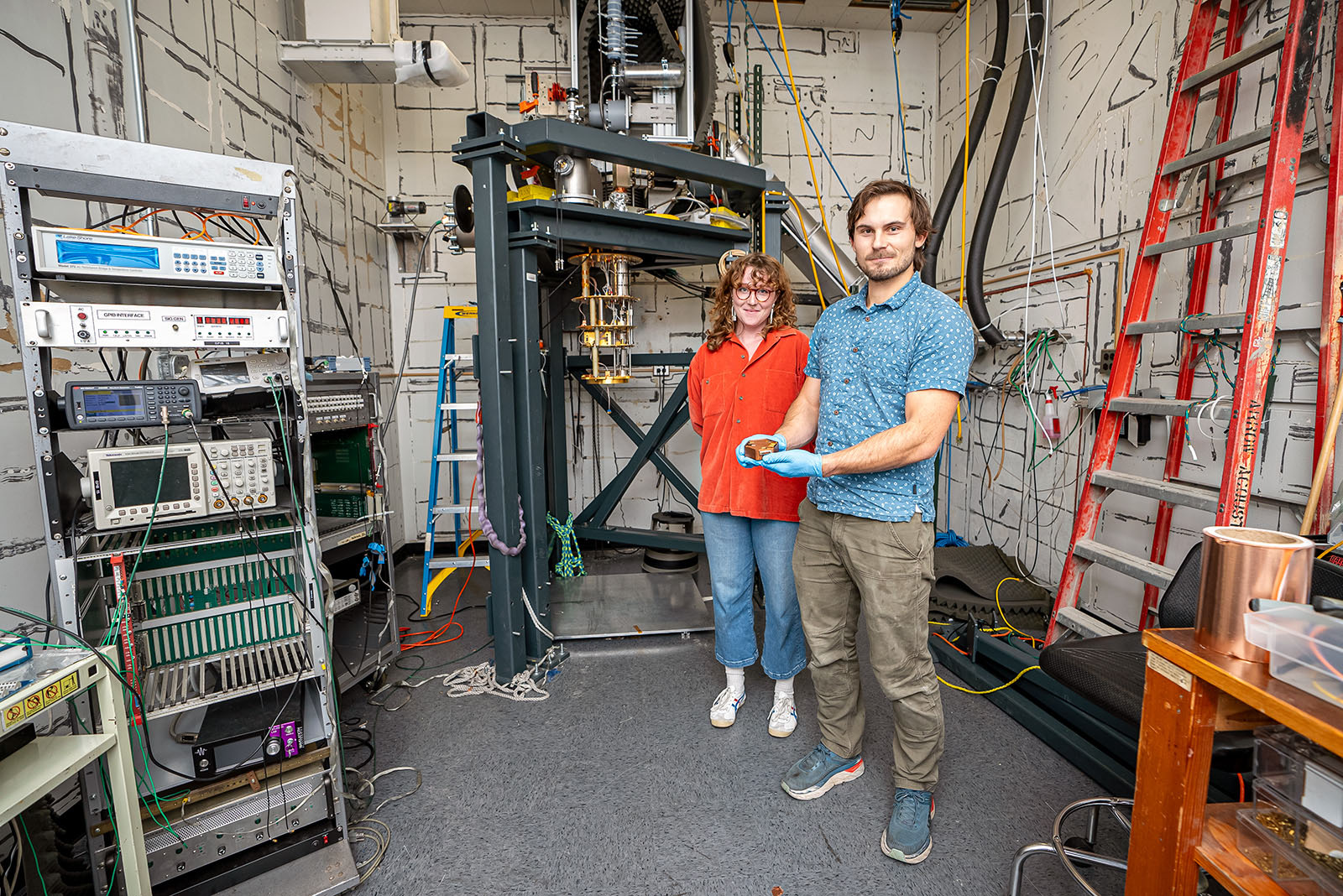Small But Mighty: TESSERACT Joins the Hunt for Dark Matter
Using super-sensitive detectors smaller than a stamp, a new experiment is searching for dark matter at masses no other experiment has explored.

For decades, people have been trying to directly detect dark matter: the missing mass in our universe. Now, there’s a new, super-sensitive detector on the case — and even though it’s still in the research and development phase, it’s already been able to search for kinds of dark matter that other detectors can’t reach. Historically, most dark matter searches have hunted for two particular kinds of dark matter: ultra-light axions and heavier WIMPs (weakly interacting massive particles). But the new TESSERACT experiment - with contributions from UZH professor Björn Penning - searches in between these regimes, looking for low-mass dark matter that’s about a hundred to a thousand times lighter than a WIMP. TESSERACT stands for Transition-Edge Sensors with Sub-EV Resolution And Cryogenic Targets,see full press release.
In a paper submitted 5 Marchhttps://arxiv.org/abs/2503.03683, TESSERACT researchers presented their first dark matter results, finding no evidence of low-mass dark matter between masses of 44 MeV/c2 and 87 MeV/c2 (where MeV is millions of electronvolts). For comparison, the mass of a proton is slightly less than 1,000 MeV/c2, and the most recent results by LZ, the world’s best WIMP experiment, searched for dark matter down to 9,000 MeV/c2. This is the first time any experiment has searched for nuclear recoil signals from dark matter with mass below 87 MeV/c2.
While many advanced dark matter experiments use huge volumes of detector material or giant magnets, TESSERACT’s power comes not from its size but its sensitivity. The new world-leading results came from carefully instrumented and shielded silicon chips that are one square centimeter, roughly a quarter of the size of a postcard stamp. These detectors were designed at UC Berkeley and fabricated at Texas A&M University.
-

- Zoom (JPG, 492 KB)
-
TESSERACT uses special transition-edge sensors, the thin strips visible on square silicon chips. Credit: Marilyn Sargent/Berkeley Lab
TESSERACT uses transition-edge sensors, a type of superconducting detector, that operate at around 8 millikelvin (nearly negative 460 degrees Fahrenheit). Adding even a minuscule amount of heat – say, from a lightweight dark matter particle bumping into the chip and depositing some energy – can trip the sensor.
“We’ve been working to make the sensors very consistent and high-fidelity at very low temperatures,” said Vetri Velan, a Chamberlain Fellow at Berkeley lab and co-lead of the analysis. “The lower the transition temperature of the sensor, the better the noise performance and the better the sensitivity to dark matter. So it’s all about how sensitive we can make these sensors.”
Researchers have been conducting R&D since 2020 to increase the sensitivity and reduce (or account for) potential sources of noise that might hide a dark matter signal. That includes finding the right recipe for manufacturing the sensors and reducing background vibration and electromagnetic interference in the dilution refrigerator that houses the silicon chip. The detector’s small size is also an asset; less area means fewer background interactions.
-

- Zoom (JPG, 402 KB)
-
A researcher at UC Berkeley, examines a TESSERACT sensor. Credit: Marilyn Sargent/Berkeley Lab
An Experiment Designed to Change
Most dark matter experiments are placed deep underground, using thousands of feet of rock to help block out particles from space that can interact in the detector. With this first detector prototype, TESSERACT has already explored new spaces for dark matter from what is essentially Earth’s surface: the sub-basement of UC Berkeley’s Birge Hall.
But to further improve the detectors’ sensitivity, researchers plan to install the full experiment beneath 1,700 meters of rock in the deepest underground laboratory in Europe: France’s Modane Underground Laboratory. Construction is slated to begin in 2025, with the experiment coming online around 2029 and searching for dark matter with masses as low as 10 MeV/c2. The experiment will grow from its current footprint, roughly as big as a phone booth, to a six-foot cube.
The heart of TESSERACT is its transition-edge sensors, but researchers are also developing additional detector modules that improve their odds of spotting dark matter. HeRALD (Helium Roton Apparatus for Light Dark matter) will be the first time that a dark matter experiment uses superfluid helium, and will incorporate TESSERACT's silicon chips as the detector's sensors. SPICE (Sub-ev Polar Interactions Cryogenic Experiment) will use single crystals of sapphire and gallium arsenide. And the science teams in France will contribute a sensor made of silicon and germanium. The different modules will give researchers unique ways to search for dark matter and test different theories.
-

- Zoom (JPG, 511 KB)
-
Works on TESSERACT’s dilution refrigerator. The setup holds and cools the dark matter detectors. Credit: Marilyn Sargent/Berkeley Lab
The shielding that will surround the experiment is designed to come apart, making it possible for researchers to easily access TESSERACT’s components and switch things out in a matter of days. If HeRALD sees intriguing signs of dark matter, scientists can swap in SPICE and cross-check the result (or vice versa). In contrast, many advanced dark matter experiments are built like a ship in a bottle; it would take them months or years to open up and swap components, if it could be done at all.
Researchers are currently continuing to develop HeRALD and SPICE and testing new manufacturing processes to further improve the transition-edge sensors. “To get TESSERACT to the sensitivity we want, these detectors have to get even better, even though they’re already the best in the world,” Williams said.
Improved detectors and a subterranean home will let the experiment search for lower mass particles and increase the chance of detecting ultra-rare dark matter interactions with regular matter.
The UZH group of Björn Penning contributes to shielding and site settings and a former student (Michael Williams) played a leading role on the paper.